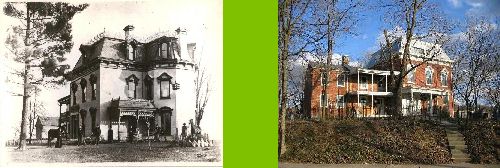I used to be a stain and polyurethane man. Not necessarily by choice, more the result of limited knowledge. Most people and places promote stain and urethane because it is relatively easy to comprehend and polyurethane is the wonder finish of the last 30 years. Durable and long lasting. Now I'm a shellac kind of guy, warm and glowing, not partial to standing water and more vulnerable to daily wear and tear. However, with just a little alcohol I'm easy to restore to my glowing self!
If you asked me about shellac three years ago I couldn't tell you much. I grew interested in the stuff after reading books on decorative finishes. Shellac was mentioned a few times as a wood sealer and was used to give objects an aged plaster look which interested me since we planned on using ceiling medallions in the "Crackhouse". My first encounter with shellac was actually around 1997 when I stripped some woodwork and a floor. I couldn't figure out what the gooey brown stuff was that was clinging to my scraper, why there was so much of it and why it smelled so bad when it burned. After it was all removed and the woodwork and floor refinished with stain and polyurethane I didn't think about it any more. Then we bought the "Crackhouse" which we affectionately refer to as "House II" or "The Mansion".
We had no plans to restore the painted woodwork in the place. There was too much of it and we didn't know what it looked like originally. We did plan on sanding the floors though. Then I was able to acquire a copy of a journal written in 1936 about the family that lived here and it contained some descriptions of the house. As we tore out the masonite panelling and removed partitions that were built to render the building useful as apartments we began to expose woodwork and wallpaper that had been concealed for 50 years.
This is when I started to discover what shellac actually was. My first encounter with the stuff where I knew what I was dealing with was when I cleaned a slate fireplace mantle with alcohol and the red finish came off. Shellac on slate? Hmmm, there something I wouldn't have thought of. Someone gave me a red colored porcelain door knob and I cleaned it with alcohol. The red came off and it was in fact a white door knob. Hmmm, shellac on a door knob? I used alcohol on some original dark woodwork and the dark finish came off leaving unstained wood. Hmmm, the shellac is tinted, not the wood? The real clincher came when I started to strip some wood of paint. In some areas the top layers of paint came off revealing the "original" wood finish. The only problem was the "original" finish was painted on. There was a red colored translucent glossy finish over a pale green paint that was on top of a beige. When rubbed with alcohol the red finish came off. Whodathunkit? Shellac over paint? So now I was intrigued and soaked up every tidbit of information that I could about shellac. I will tell you what I found out in the next exciting episode. Stay tuned to this blog!

7 comments:
Hallelujah! Preach it brother!
Fantastic! -- I have been always been a fan of shellac -- so easy to repair and with a bit of futzing you can do amazing things with it. Glad to see that you discovered it.
a little side note: Years ago during prohibition it was rumored that people actually drank the stuff as it was mixed with alcohol - hence the term - getting or being shellaced - since it was also commonly used on furniture - all wood surfaces - people would refer to drinking it in terms of drinking furniture polish.
Its warm glow is uncomparable -on wood that is (not drinking) heh heh.
Have fun on your discovery!
Keep experimenting!
Love your site!
Alcohol removes shellac? What kind of alcohol are you talking about here? I am thinking maybe this is what is on our woodwork? I used ammonia on the stairs and it took off the entire finish so I assumed it was wax. Now I am confused as all the wood in our old house has an orangey-gold-red tint to it. Hmmmmm....
Spread the Word. I just redid an old oak table with shellac. Cleaned it up wiith denatured alcohol and put some orange shellac on it. This poor old thing looks great. Keep up the great info. I love your blog and all your advice.
Susan
I am no respecter of cheap wood and I'm painting over an old table with a creamy semi-gloss and plan on doing some Hawaiian flower art on it this evening if it is dry. This table has been painted before but the paint peeled off completely, so I sanded it last evening before applying a very thin coat of paint and allowed it to dry. On my lunch break today, I thought I would put a final coat on before the artwork and found (gasp) a bubble which could start a peeling effect again. So, my question is....could I shellac the entire thing when I'm finished with the art? Would that seal the paint in? I love shellac! Please tell me this will work.
I painted orange shellac over white oil based paint on a staircase. People ooh and ah over it. I see all the brush marks where I started and stopped. What did I do wrong?
Because the solution is alcohol based it evaporates quickly. You have to work quickly to avoid lap marks. It may work better to use a smaller brush and apply more thin layers. I have applied as many as five on some surfaces though three will usually do the job. I don't use brushes wider than 1" on vertical surfaces and 2" on floors.
Post a Comment